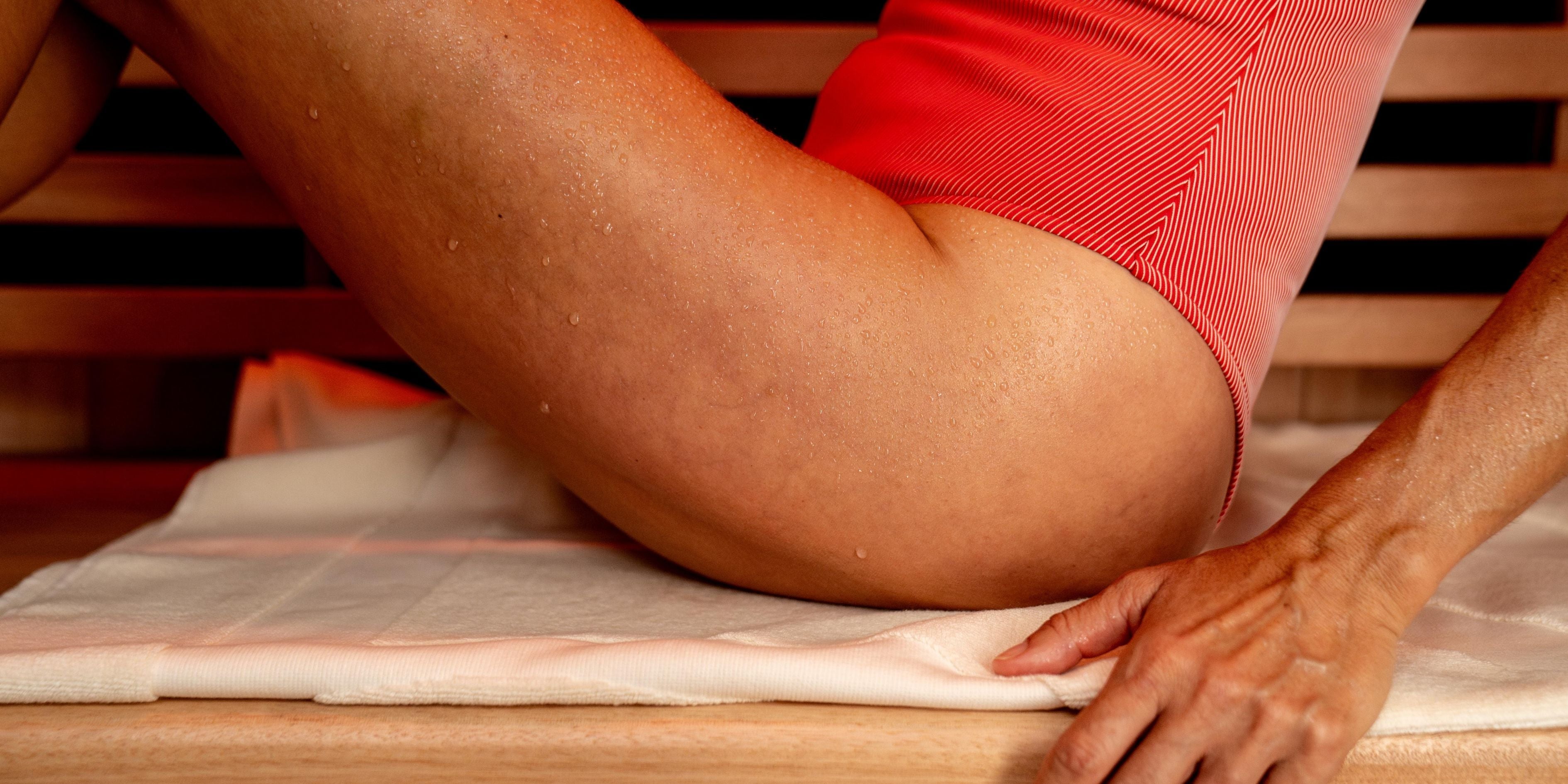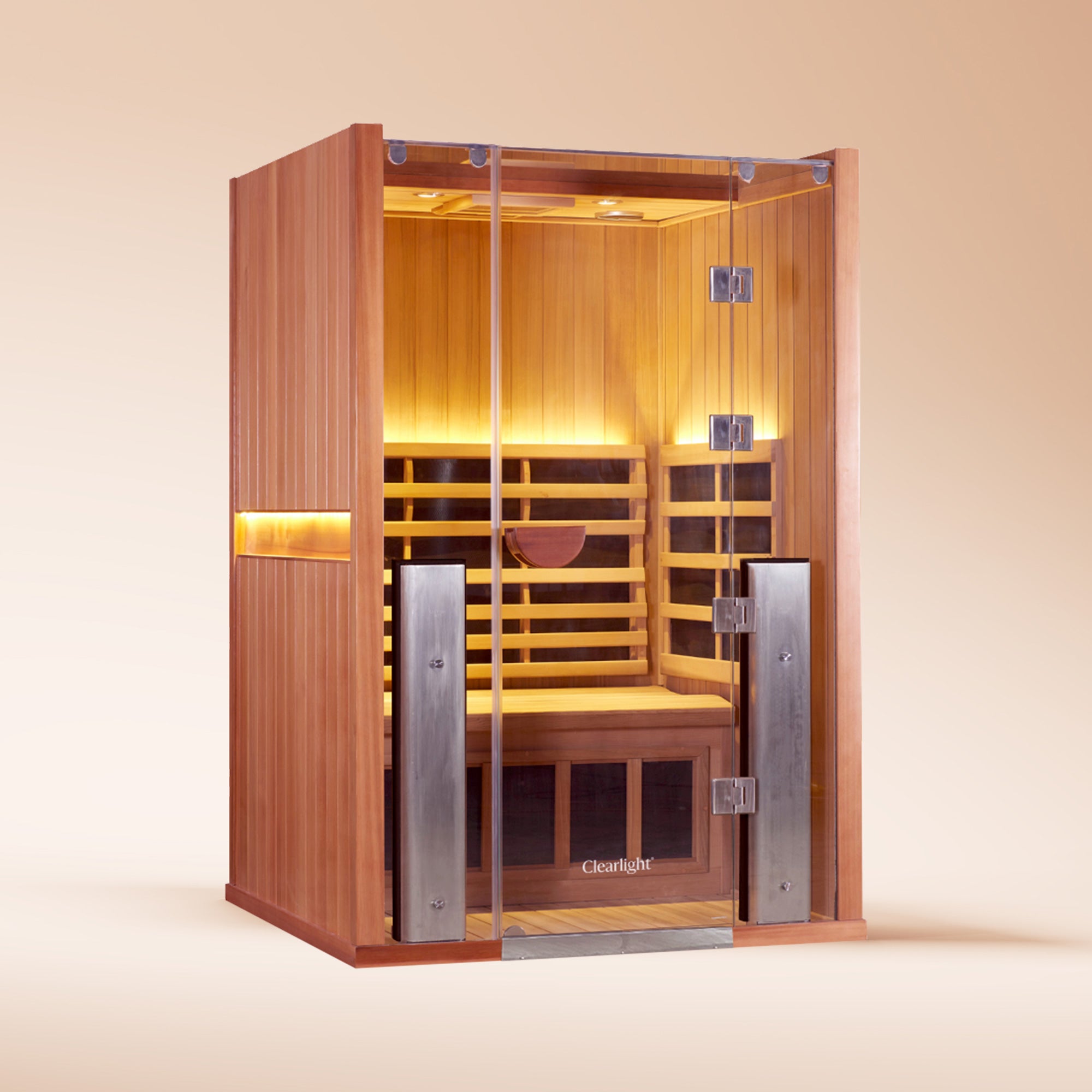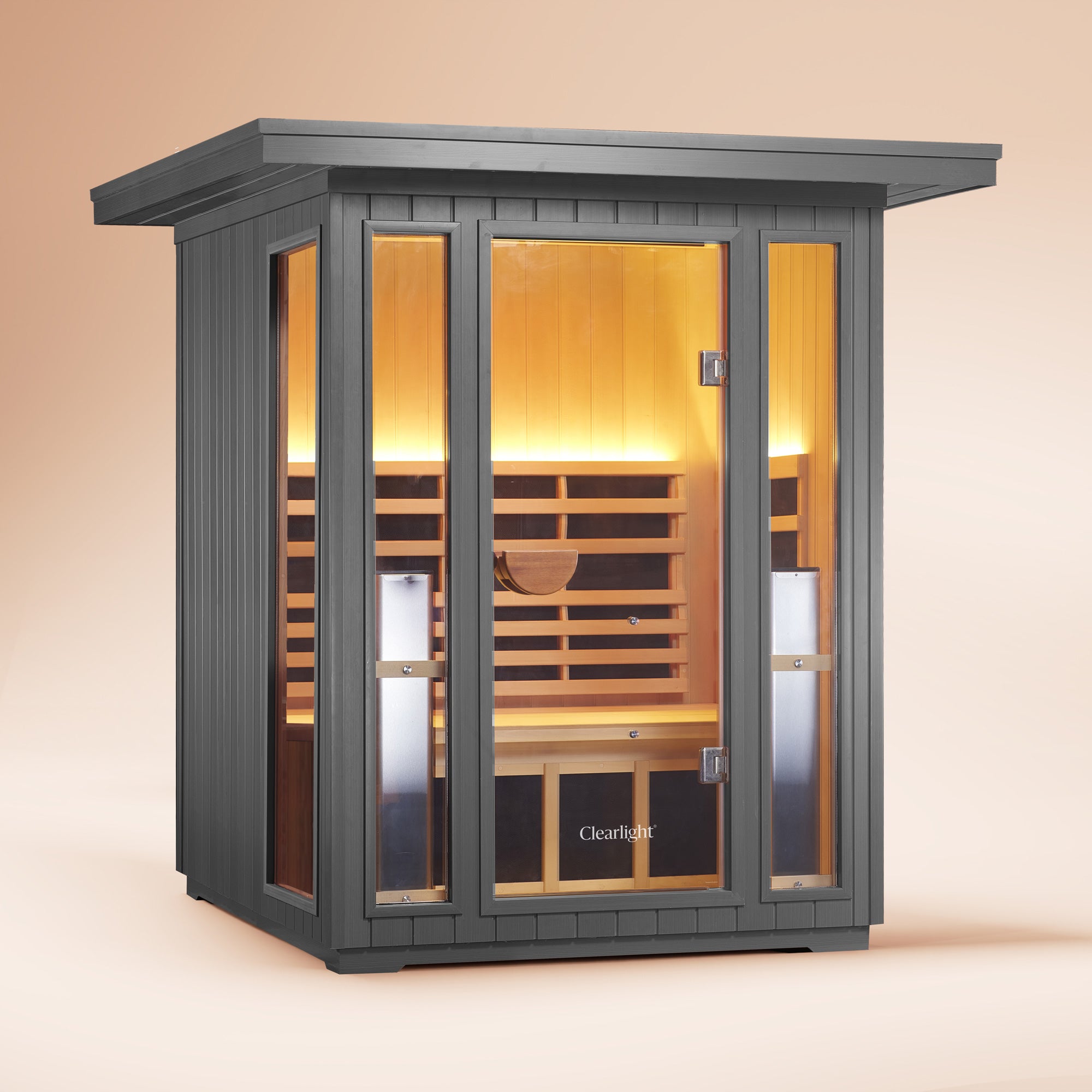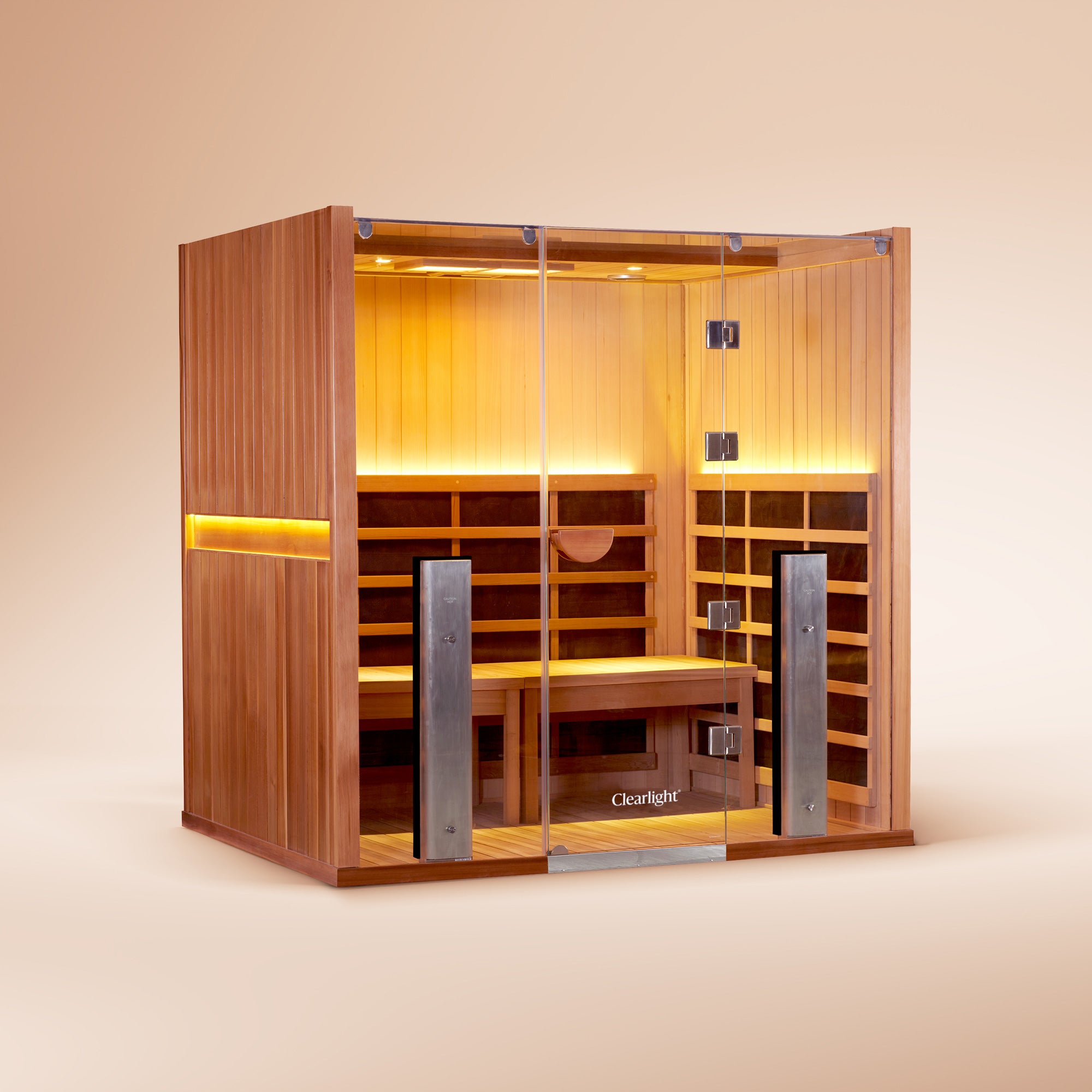In this blog post, I’ll talk about all the infrared light therapy at home options. This topic is quite confusing for many people as many different options exist.
For that reason, I’ll distinguish between:
Infrared sauna therapy - which heats up your body using infrared light & heat.
Near-infrared light therapy - which doesn’t heat up your body. Usually, near-infrared light therapy devices not only expose you to the infrared light spectrum but also
Don’t worry if this all sounds complicated. I’ll break down what infrared light is - and other types of light - in the next section.
So let’s start with infrared sauna therapy:
Infrared Sauna Therapy
I’m asked all the time:
- “Johannes, what’s the difference between an infrared sauna and a Finnish sauna?”
- “I read about far infrared saunas online, but people also say that near-infrared is better or that you only need far infrared. What’s the truth”?
- “Will near-infrared light therapy heat my body like a sauna does?”
At the end of this blog post, you’ll have a full understanding of how to answer these questions. But first, I’ll have to take a step back and talk about the “light spectrum” in physics. That light spectrum gives you a much deeper understanding of how to distinguish between the different therapies:
Light Spectrum Basics
To understand all the differences between saunas and infrared light therapy at home, I’ll first consider light from a physics perspective. Simply put, three main different types of light exist: ultraviolet light, visible light, and infrared light. Only visible light can be seen with the naked human eye - ultraviolet and infrared are invisible without scientific tools.
I won’t focus much on ultraviolet light in this blog post. Ultraviolet light is what can give you a sunburn if you’re excessively exposed and can help create vitamin D in your skin. Visible light, moreover, consists of all the colours of the rainbow: violet, blue, green, yellow, orange, and red. And, lastly, the main topic of this blog post - infrared - is what makes sunlight feel hot on your skin.
In physics, there’s a strong link between infrared light and heating (1; 2; 3; 4; 5). Your own body also emits infrared light. That infrared light can be seen on security cameras at night, for instance. Infrared light is thus very natural to the human body.
And, by exposing your body to infrared light (or heat), your body temperature goes up. Medical science talks about a rise in “core body temperature”, which has all kinds of potential health benefits.
Lastly, I’ll have to cover the different types of infrared light - I’ll do that in the next section:
Different Types Of Infrared Light: Near Infrared, Middle Infrared, Far Infrared
The different types of infrared light are the key to understanding the differences between infrared sauna therapy and near-infrared light therapy. I’ll distinguish between “near infrared”, “middle infrared”, and “far infrared” heat here (6; 7; 8). The difference between these types of infrared is the “wavelength’. Near-infrared, as the name already suggests, has the shortest wavelengths. Middle infrared has a longer wavelength and far infrared has the longest wavelength.
These wavelengths can be measured:
- Near-infrared light is found between ~0.8 and 3 micrometres
- Middle infrared light has wavelengths between 3 and 50 micrometres
- Far infrared light, lastly, is emitted at wavelengths between 50 and 1,000 micrometres
(Different categorisation schedules exist for distinguishing between these types of infrared. I’ve taken a schedule that’s quite commonly used, the ISO 20473 standard.)
These three different types of infrared light all have different effects when your body is exposed to them. Different types of infrared light penetrate the human body to different extents, and, also affect tissues to different degrees (9; 10; 11; 12; 13; 14; 15). For instance, it’s much harder for most types of light to penetrate bone than to go through the skin and muscle tissue. For that reason, getting near infrared or far infrared exposure to your brain will be different than to your arms.
The most important thing here is to understand that infrared light or infrared heat (which are almost indistinguishable) heat the body from the inside out. A traditional sauna works the opposite way: it heats the air, and that air then indirectly heats your body.
Using infrared light has advantages though: the experience is very gentle compared to a traditional sauna. A traditional sauna has a maximum temperature of 110 degrees Celsius while that’s only 60 degrees for an infrared sauna.
Most heat in a traditional sauna is also located near the top of the sauna, not the bottom. The problem with that approach is that your head and skull are your weakest link - the head is first to give out when you’re spending time inside the sauna. High-quality infrared saunas take the opposite approach - heater panels are only aimed at your body, never your head - so that the correct tissues are heated up.
Also, with an infrared sauna, you won’t be breathing in extremely hot air. Those two factors alone make infrared sauna therapy much more gentle. And, despite that gentleness, an infrared sauna will still give you extremely good increases in the aforementioned “core body temperature”. So, you get the same results with a more gentle experience.
Different types of infrared light also have different biological effects. For instance, there’s an “absorption peak” of around 3 micrometres, then again around 10.5 micrometres, and around 60 micrometres.
In plain English, these absorption peaks entail that they’re ideal for heating up your body from the inside out. And, because the absorption peaks are located in both the near, middle and far infrared spectrum, getting exposure to all of them is ideal if you want to increase your core body temperature to the maximum extent possible. For that reason, we offer full-spectrum infrared saunas, that combine all three types of infrared.
The effects of infrared light on your body are far more extensive than just heating you up though. For instance, near infrared light can be used to irradiate your blood, making it less sticky, improve circulation at the smallest blood vessels, help immune cells work more efficiently, and affect the energy created in your cells directly (16; 17; 18; 19; 20; 21; 22).
Your cells contain so-called “mitochondria”. Mitochondria can be envisioned as the energy-producing factories of your cells. Energy creation in your mitochondria is an extremely complex process of many different chemical and physical elements. Scientists don’t fully understand that process to this day. However, what is known is that certain steps of that energy-creation process work more efficiently with near infrared light exposure.
And, like the aforementioned energy-creation process, new discoveries on how infrared light exposure supports health are found every day. I’ll be following these trends with great interest and keep reporting on them on this blog.
Next up, now that you understand infrared light and the differences between different types of infrared, let’s consider how infrared sauna therapy works:
Infrared Sauna Therapy Or Infrared Heat Therapy: The Many Benefits
First, let’s consider “infrared sauna therapy” or “infrared heat therapy”. Both are basically synonyms for the same phenomenon. In this case, you’re using an infrared sauna to heat your body from the inside out.
Below I’ve added a picture of such an infrared sauna. Traditionally, these saunas use heater panels to expose your body to infrared light. These heater panels used to emit mostly far infrared light in the past.
Nowadays, sauna technology has developed. For that reason, you can also expose your body to near and middle infrared light today. To expose you to all types of infrared, at Clearlight Infrared® Saunas. , True Wave™ Full Spectrum infrared heaters can be installed in any sauna we offer. These heaters have also been designed to emit as little “EMF” or “Electro-Magnetic Frequencies” as possible so that each of your sessions fully supports health.
So why would you use infrared heat therapy using a sauna?
Well, in a previous blog post, I summarised all of the different benefits of infrared sauna therapy. I’ll briefly cover some of the most important infrared sauna therapy benefits:
- Massively improves your general health. As a result, your overall risk of dying decreases. That risk is called “all-cause mortality” in medicine. Simply put, people who use an infrared sauna regularly will reduce their risk of dying because many diseases and bad outcomes are prevented (23). That lower risk of dying can be understood through lowering your chances of getting heart disease and things like a stroke, and reducing the risk of airway health conditions (24; 25). Your blood pressure also goes down the more frequently you spend on infrared sauna therapy (26; 27).
- Counters chronic pain. Many more people suffer from chronic pain than diseases such as heart and blood vessel conditions and diabetes combined. And yet, chronic pain is really underappreciated in modern society because there’s not always a direct biological cause for the pain and you cannot directly observe pain from outside the body. But, for some types of chronic pain, such as tension headaches, fibromyalgia, and nerve pain, infrared sauna therapy will make you feel much better (28; 29; 29).
- Boosts recovery after a workout (30; 31). Athletes will love this benefit, and benefits for both endurance athletes and those with explosive sports have been found. Saunas, in general, also improve blood circulation and the number of red blood cells in your body - further helping recovery and athletic performance.
- Enhances blood circulation (32; 33). Of course, better blood circulation is a benefit that stands on its own. With better circulation, it’s easier for the body to remove waste products and to move nutrients to places where they belong, such as your cells.
- Increases detoxification (34; 35; 36; 37). Some toxins, such as heavy metals, phthalates, plastics (Bisphenol A comes to mind), and byproducts of drugs, are preferably exrected through the skin. For others, your liver, urinary system, and stools take the preference, but that’s not the case for all toxins. As a result, the more you sweat, the more you detoxify.
- Makes you feel great and likely boosts sleep quality (38; 39; 40). Feeling better and sleeping better is of great benefit in an overstressed and sleep-deprived society. Relaxation and stress reduction are the most frequent reason people actually visit a sauna. And, almost 85% of people who use a sauna report deeper sleep at night. Spending time inside a sauna also helps your body release natural opioids called “endorphins” that make you feel great.
- Helps you lose body fat. Sure, feeling great is amazing but looking better at the same time is even more perfect. We’ve carried out some of our own weight loss research using infrared therapy at home and the results are extremely promising.
Additionally, I want to cover a few other infrared heat therapy devices, that mimic a sauna - I’ll cover these in the next section:











Infrared Salt Sauna: Why This Magical Combination Works Wonders
Ice Baths vs. Infrared Saunas: The Cold Truth